As a homeowner, there are so many things to consider. One very important thing to consider is your water quality. With so many filtration options available, how do you know which type of filter and micron rating you should use?
In this blog post, we will go over the difference between point of entry (POE) filters, spin-out filters and point of use (POU) filters. We will also discuss micron ratings.
Please note that the following point of entry, spin-out and point of use filters  are not water treatment devices. In other words, they cannot make unsafe water safe to drink. Before selecting a water filtration system, get your water tested to ensure it is safe for consumption. If your water contains harmful bacteria, you will need a water treatment professional to select and install an appropriate water treatment system such as a reverse osmosis or ultraviolet filtration system.
are not water treatment devices. In other words, they cannot make unsafe water safe to drink. Before selecting a water filtration system, get your water tested to ensure it is safe for consumption. If your water contains harmful bacteria, you will need a water treatment professional to select and install an appropriate water treatment system such as a reverse osmosis or ultraviolet filtration system.
Micron ratings
A micron rating is the measurement of the distance between pieces of filter media. In other words, a micron rating determines the particle size that is allowed to pass through the filter.
Point of entry filter
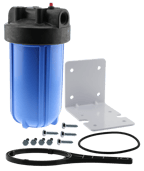 Whether your water supply is from a ground water well or a municipal water system, a point of entry filter, also known as a whole house filter, protects your entire plumbing system from sediment and/or particulate. A POE filter ensures that the water going out to all appliances will be free of particulate. It protects appliances like your boiler, iron filter, water softener, water treatment equipment and laundry machine. Typically, POE filter cartridges are 10 microns or higher. 20 to 50 micron cartridges are commonly used to filter out larger sediment.
Whether your water supply is from a ground water well or a municipal water system, a point of entry filter, also known as a whole house filter, protects your entire plumbing system from sediment and/or particulate. A POE filter ensures that the water going out to all appliances will be free of particulate. It protects appliances like your boiler, iron filter, water softener, water treatment equipment and laundry machine. Typically, POE filter cartridges are 10 microns or higher. 20 to 50 micron cartridges are commonly used to filter out larger sediment.
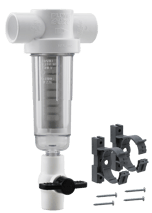
Spin-out filters
Spin-out filters can be added in series as a pre-filter before reaching the point of entry or whole house filter. Spin-out filters have a mesh screen and are designed to remove large volumes of sediment using centrifugal force.

If your water is from a well and has sand or silt, you should consult a water well expert. The presence of sand or silt indicates that the water is being pumped from the well too rapidly. This issue can be easily corrected by reducing the pumping rate. The pumping rate can be reduced by installing a flow control to reduce the gallons per minute (GPM) being pumped from the well.
Point of use filter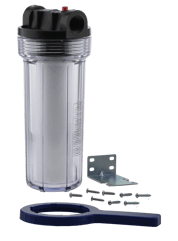
A point of use filter can be installed before an appliance to protect it from sediment or before a drinking water faucet to remove bad taste and odor. There are many types of POU filters to choose from and each one has their own purpose and advantages. For example, a POU filter can be equipped with a lower 5-10 micron rated sediment filter cartridge to protect an expensive appliance from even smaller pieces of sediment.
The most common POU filter is an activated carbon filter cartridge. An activated carbon filter cartridge removes undesirable taste and odors like chlorine. There are a variety of carbon filters available such as a cannister type granular activated carbon (GAC) filter, a wrapped carbon powder (CW) filter, a carbon block (CB) filter, a carbon briquette cyst removal (CCR) filter and a carbon ice maker (IM). All enhance drinking water quality and filter water that goes out to your drinking water faucet, fridge dispenser and ice marker.

![]()


RO and UV filter systems
Both reverse osmosis (RO) and ultraviolet (UV) filter systems require that a pre-filter is installed first. In an RO system, pre-filters protect the RO membrane from particulate. In a UV system, water needs to be pre-filtered first through a sediment cartridge 5 microns or smaller. 5 microns is needed to ensure that harmful bacteria in the water cannot hide behind sediment as it passes through the UV filter. Please be sure to carefully follow the installation instructions provided by the UV filter manufacturer.
Hopefully, this blog post has helped you understand the difference between point of entry filters, spin-out filters and point of use filters, and has helped you choose the right filtration system for your home. For more content on water quality, check out our blogs on 8 tips to improve your household water quality and 8 things every first-time homebuyer should know.


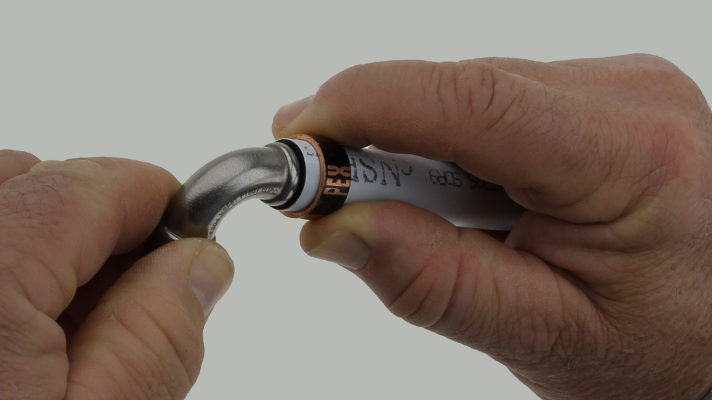
-1.png)
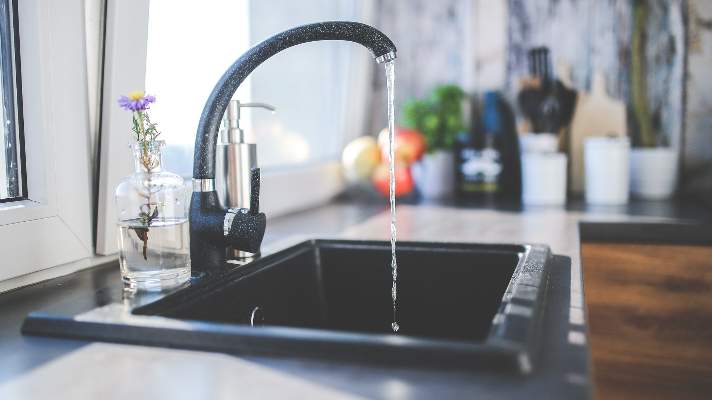
SHARE